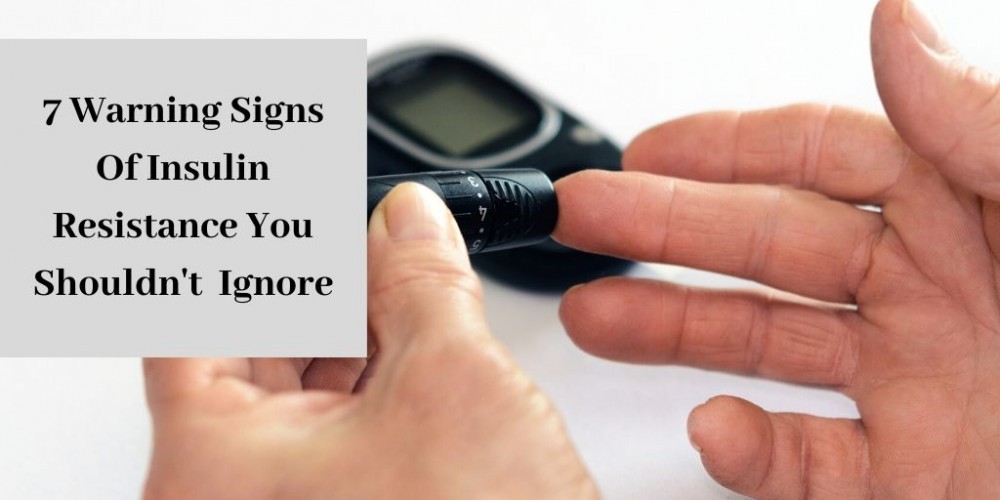Did you know you can have insulin resistance and not know it? The tissues in your body become resistant to insulin gradually without you being aware of it. That’s why it’s important to know the warning signs of insulin resistance, a condition of chronic inflammation and high blood sugar, and a precursor to obesity, metabolic syndrome, diabetes, and cardiovascular disease.

Low-grade inflammation and blood-sugar disruption is a risk factor for many diseases, including cancer. The sooner insulin resistance is recognized, the easier it is to reverse it. Keeping your blood sugar and insulin levels in a healthy range is essential if you want optimal health.
Table of Contents
What Is Insulin Resistance?
Insulin resistance (IR), or impaired glucose tolerance, is a condition in which the body fails to respond effectively to insulin, a hormone secreted by the pancreas that keeps blood sugar levels in the normal range. When levels of insulin are chronically high due to high-carb diets, overtime, tissues stop responding to its effects.
This failure to respond causes the pancreas to secrete more and more insulin in order to keep glucose levels stable, further compounding the problem. Blood sugar levels are able to remain stable as long as the pancreas can continue to crank out enough insulin to enable glucose to enter the cells.
Insulin resistance also correlates with high blood pressure, PCOS, fatty liver, mental health disorders, and Alzheimer’s. Once the liver, muscles, and fat cells become resistant to insulin, and can no longer store glucose to protect the body from the effects of high blood sugar, the blood vessels and eventually the kidneys, will be negatively impacted.
[Read More: Can Non-Alcoholic Fatty Liver Disease Be Reversed?]
#commissions earned
Some studies suggest that close to 45% of the US population may suffer from impaired glucose tolerance, with many being completely oblivious to the fact they have the condition. This is because symptoms are not apparent in the beginning stages.
As the condition worsens and blood sugar levels continue to rise, symptoms of pre-diabetes and diabetes begin to manifest, and can no longer be ignored. Symptoms include fatigue, slow wound healing, infections, blurry vision, extreme thirst, and frequent urination.
The Progression Of Insulin Resistance
Insulin resistance is much easier to reverse when it’s detected in the early stages when it will respond favorably to changes in diet and activity levels. Unfortunately, it’s often not diagnosed until blood sugar levels have been high for years.
Ideally, the condition would be diagnosed when high insulin levels could be detected on a routine blood screening, however only glucose levels are generally accessed, and typically appear normal because insulin is still able to get glucose into the cells and out of the bloodstream.
It can take years for insulin resistance to develop into pre-diabetes and type II diabetes. The condition begins with normal glucose levels and increasingly rising levels of insulin, which can drop the glucose levels below normal.
As the degree of resistance progresses, insulin levels gradually begin to fall, with blood sugar levels gradually climbing. At this stage, both insulin and glucose would appear to be in the normal range on a blood chemistry panel, and people are told they are “normal.”
Signs Of Insulin Resistance
Some signs of IR are easier to recognize than others. For instance, it’s obviously apparent when you are consistently packing on the pounds, but you may be unaware that your blood pressure, cholesterol, and triglycerides are also creeping up. A comprehensive blood panel is a good option for accessing these levels.
Comprehensive Blood Panel
1. Abdominal Weight Gain
Insulin plays a critical role in regulating fat storage. When insulin levels are high, fat cells turn glucose into fat via a process called lipogenesis. In order to use fat for energy, insulin levels must be low. This is why people with insulin resistance not only gain weight, they also have a hard time losing it, because fat is not able to be burned for fuel.
Abdominal weight gain is one of the first signs that cells are becoming resistant to insulin. A waist measurement exceeding 40″ in men and 35″ in women is a red flag for insulin resistance.
2. Inability To Lose Weight
As stated above, people with insulin resistance gradually put on visceral fat in the abdominal area. At some point, they may decide to tackle the problem by exercising more and making substantial changes to their eating habits.
But because they have high insulin, diet and exercise no longer work like they used to. How well they work will depend on their degree of insulin resistance.
Because insulin regulates the burning and storage of fat, and levels must be low to burn fat for energy, a significant drop in weight will not occur until insulin levels are reduced. This can be frustrating because it will take time before the scale starts to budge. However, eating fewer carbs and increasing activity levels are mandatory for lowering levels of insulin.

 3. Cravings For Carbohydrates
3. Cravings For Carbohydrates
Insulin is an anabolic, or building, hormone. High levels can cause intense cravings. We all have cravings sometimes, with mineral deficiencies and hormonal swings being common culprits. It’s unusual for people to satisfy their cravings with healthy fat and mineral-dense foods.
Instead, they eat more carbs, which only intensifies the problem. People with insulin resistance often have cravings even after they’ve eaten a full meal. If they give into these cravings, the pancreas will secrete more and more insulin to keep blood sugar levels stable, making the cells further resistance to insulin.
4. High Glucose And High Insulin
Many people have high blood sugar or high insulin and have no idea their levels are off. A comprehensive blood chemistry panel can provide vital insights into how glucose and insulin are behaving. Fasting insulin should not exceed 5 mcU/ml, with many functional practitioners believing that number should be closer to 3.
A normal fasting glucose will be under 100 mg/dL. Levels between 100-125 mg/dL are indicative of pre-diabetes, and numbers over 126 mg/dL signal diabetes. Insulin resistance is associated with gradually rising blood pressure. Readings over 130/80 are cause for concern, especially if the numbers continue to rise.
Although, it’s not possible to access your insulin levels from home, it is possible to check your fasting and after-meal blood sugar levels by using a glucometer. You can keep an eye on your blood pressure by checking your levels periodically using a reliable blood-pressure monitoring system.
The A1C is a diagnostic, three-month measure of glucose levels. Under 5.7% is considered normal, with between 5.7% and 6.4% indicating pre-diabetes, and above 6.5% diagnostic for diabetes. Functional health practitioners prefer normal levels to be closer to 4.5-5.0%.
Glucose blood test
Insulin blood test
A1C test
![]() 5. High Triglycerides And Low Levels Of HDL
5. High Triglycerides And Low Levels Of HDL
Elevated triglycerides and low levels of HDL cholesterol are both warning signs of insulin resistance, especially in conjunction with high glucose and insulin. Triglycerides are a common type of fat found in the blood that functions as a primary energy source. Excess calories, either in the form of protein, fat, or carbohydrate, are stored as triglycerides to be used at a later time.
High triglycerides are the result of eating more calories than you burn, and can be a sign of insulin resistance or metabolic syndrome, a condition of high blood sugar, high blood pressure, abdominal fat, and low HDL cholesterol. Metabolic syndrome can lead to diabetes, stroke, and heart disease. Normal amounts of triglycerides are necessary for optimal health, but levels should not exceed 150 mg/dL. Triglycerides over 499 are considered extremely high.
HDL cholesterol, considered the “good” cholesterol, scavenges bad cholesterol from the bloodstream, and protects the endothelium of blood vessels. This is significant because damaged endothelium can lead to artherosclerosis, heart disease, and stroke. High levels of HDL decrease cardiovascular risk, whereas low levels increase risk. Under 40 mg/dL in men and under 50 mg/dL in women are considered healthy.
A Comprehensive CardioMetabolic Profile measures fasting insulin, hemoglobin A1C, triglycerides, CRP (an inflammatory marker), and both HDL and LDL cholesterol.
6. Acanthosis Nigricans
A subtle symptom of insulin resistance is a skin condition called acanthosis nigricans, characterized by dark, velvety patches on the skin. These dry patches can occur on the back of the neck, elbows, knees, groin or armpits. Skin tags may also be visible. These growths can be caused by insulin resistance because insulin is an anabolic hormone that stimulates cell growth.
7. Increased Urination And Extreme Thirst
Increased urination and extreme thirst are common symptoms of the early stages of diabetes, a result of insulin resistance. As glucose accumulates in the blood, the kidneys have to work harder than normal to filter the excess glucose.
If the kidneys can’t keep up, the overabundance of glucose is excreted in the urine. Other fluids are also eliminated along with the glucose, leading to dehydration and abnormal thirst. This leads to a cycle of increased urination and even more thirst.
Key Points
Millions of people in the US have insulin resistance, pre-diabetes or diabetes. Initially, you won’t be able to tell you have insulin resistance. Overtime, it can lead to abdominal weight gain, an inability to lose weight, and out-of-range markers on a blood chemistry panel, including high fasting glucose, high triglycerides and low HDL cholesterol.
It’s vitally important to be aware of these warning signs of insulin resistance because the earlier the condition is diagnosed, the better the response to changes in lifestyle.
Do you have symptoms of insulin resistance? Let me know in the comments:)
References:
(1) WebMD: Insulin Resistance
(2) Healthline: Signs of Insulin Resistance
(3) Diet Doctor: What you need to know about insulin resistance
(4) NIH: Insulin Resistance & Prediabetes
(5) Centers for Disease Control and Prevention: National Diabetes Statistics Report
(6) WebMD: HDL Cholesterol: The Good Cholesterol
(7) Triglycerides Level.org: What Are Triglyceride Levels and Why Do They Matter?
(8) Medscape: Acanthosis Nigricans Clinical Presentation
(9) endocrineweb: Type 2 Diabetes Symptoms and Early Warning Signs
(10) Diabetes In Control: Dyslipidemia In Insulin Resistance: Hypertriglyceridemia And Low HDL Cholesterol
Disclaimer: “I am not a medical doctor, and therefore, cannot diagnose or treat any medical condition, nor do I claim in any way to cure disease. Please be diligent and always do your own research in regard to any material I present on this site. I claim no responsibility for any distress, whether it be physical or emotional, that may occur as a result of the information you obtain from my blog.”




Wow! Amazing article! I really like reading articles about health. Because it gives me a deeper understanding of what happens in the human body.
One of my friends has insulin resistance which at first he did not feel. However, over time, he was getting fatter and felt weak. Until one day, he went to do a medical check-up and found that he had diabetes.
However, since you are talking about insulin. I want to ask a few things:
1. Is it possible I have insulin resistance but don’t have diabetes?
2. If I have diabetes, but my diet is FREE OF CARBOHYDRATE, is it safe?
3. Are there drugs that can inhibit lipogenesis?
Please help ..
Thank you very much!
Hi Kylie,
Thanks so much for your comment. I’m glad you enjoyed my article on insulin resistance. It is pretty fascinating how the human body works. I’m sorry to hear about your friend getting diagnosed with diabetes. I’m not surprised he was weak and tired. When cells don’t get enough glucose, the body can’t make adequate energy.
In response to your questions: Yes, you can be insulin resistant without having diabetes. If insulin resistance is left untreated it will most likely lead to diabetes. Diabetics should carefully monitor their carbs, but don’t need to cut them out altogether, particularly the carbohydrates in vegetables, which are mineral-dense. Metformin is a drug used to treat diabetes, it inhibits lipogenesis.
Thanks again for reading:)
There is some very good information in your post that I was not aware of.
As an endurance athlete I had my best success with diets high in complex carbohydrates, and very quickly learned that it’s important to temper a diet high in carbohydrate with quality protein. If you don’t, taking in excessive amounts of pure complex carbohydrates can cause a rush of sugar into the system.
This is especially true after physical exertion. I would get really weak and dizzy just 30 minutes after taking in large amounts of complex carbs after a long run, but as soon as I figured it out and balanced the carbs with quality protein it made a huge difference and I never had to deal with the weakness and dizziness again.
I learned a lot about the body over the years, but there is always more to learn and I appreciate your post.
Hi Ray,
Thank you. I appreciate you reading my post and for your thoughtful comment. Yes, high carb diets can pose a lot of problems, and are the main cause of insulin resistance. The reason they cause weakness is because of the drop in blood sugar from the release of insulin from the pancreas.
You’re right, carbs should always be balanced with quality protein and healthy fat, as well. It makes a big difference. Fiber is also important. Good for you for listening to your body and learning how best to support it.
Thanks a lot for such an amazing review about Insulin Resistance and the explanation your gave.
Although, it is a hormone that not many people give importance to, it is very important. I heard about the importance of this hormone, but in all the articles I found it was not very well explained, after reading this article I was completely blown away by the insulin resistance imprint.
Thanks again for this post. If you don’t mind, I will share this article on my social media account. Good luck!
You’re very welcome. I’m glad you learned something from my article. Many people don’t understand how insulin resistance develops and progresses, which is sad, because a thorough understanding could prevent diabetes and its effects. Thank you so much for sharing my article on social media. I sure appreciate it!
Hi
It is very important to gauge the symptoms of insulin resistance as often people will dismiss it as being insignificant or class it as being unimportant. I am a great believer as we older that we should get regularly check up to make sure our bodies are acting normally, especially in terms of weight, blood pressure and blood sugar level. In this way we can gauge the development of serious conditions and nip them in the bud.
It is always best to be safe than sorry. I have heard about insulin resistance from people who have had their final warning to change the ways or they will develop type II diabetes, so you will need to change how you eat and exercise.
I think you have imparted important information that hopefully will get people who experience these problems to see their doctor and get it treated as soon as possible.
Thanks!
Antonio
Hi Antonio,
Awesome advice. Many people dismiss uncomfortable symptoms that potentially signal that something is wrong. This, of course, isn’t a good move because when you ignore symptoms, the underlying imbalance just gets worse. Keeping any eye on blood sugar, blood pressure, and weight is a great way to prevent a serious health concern.
It’s amazing to me that people can be warned about developing diabetes, yet they still won’t change how they eat and move. Perhaps, they don’t believe that the rules apply to them. It’s a sad state of affairs. Thanks so much for reading my post and taking the time to comment:)
Hello, I really want to first appreciate your effort in putting this great website together and writing this article. I believe that among all the signs of insulin resistance, craving for carbohydrates is the hardest to overcome. I have had this experience although frequent urination came as a surprise. I learned something new. Thank you!
Thank you, I appreciate that. Carb cravings are extremely hard to not give into and perpetuate the cycle of insulin resistance. Once insulin levels are reduced, they’re much easier to control.